Authors Purpose Easy as Pie Anchor Chart
Anchor Charts are a staple in upper elementary classrooms.
I love using anchor charts as part of my whole group mini-lessons.
I love giving students smaller versions of charts to glue in their reading notebooks.
I love making mini-versions of anchor charts to keep on strategy rings to use during small group lessons.
Regardless of how you like to format your anchor charts, they are a super helpful teaching and learning tool.
If you are getting ready to teach your unit or lessons on author's purpose, I have seven ideas for anchor charts that you could use as visual tools to use during your lessons.
Some of them might be familiar to you, but I bet there are a few ideas in here that you haven't considered when creating your author's purpose anchor charts.
7 Ideas for Author's Purpose Anchor Charts
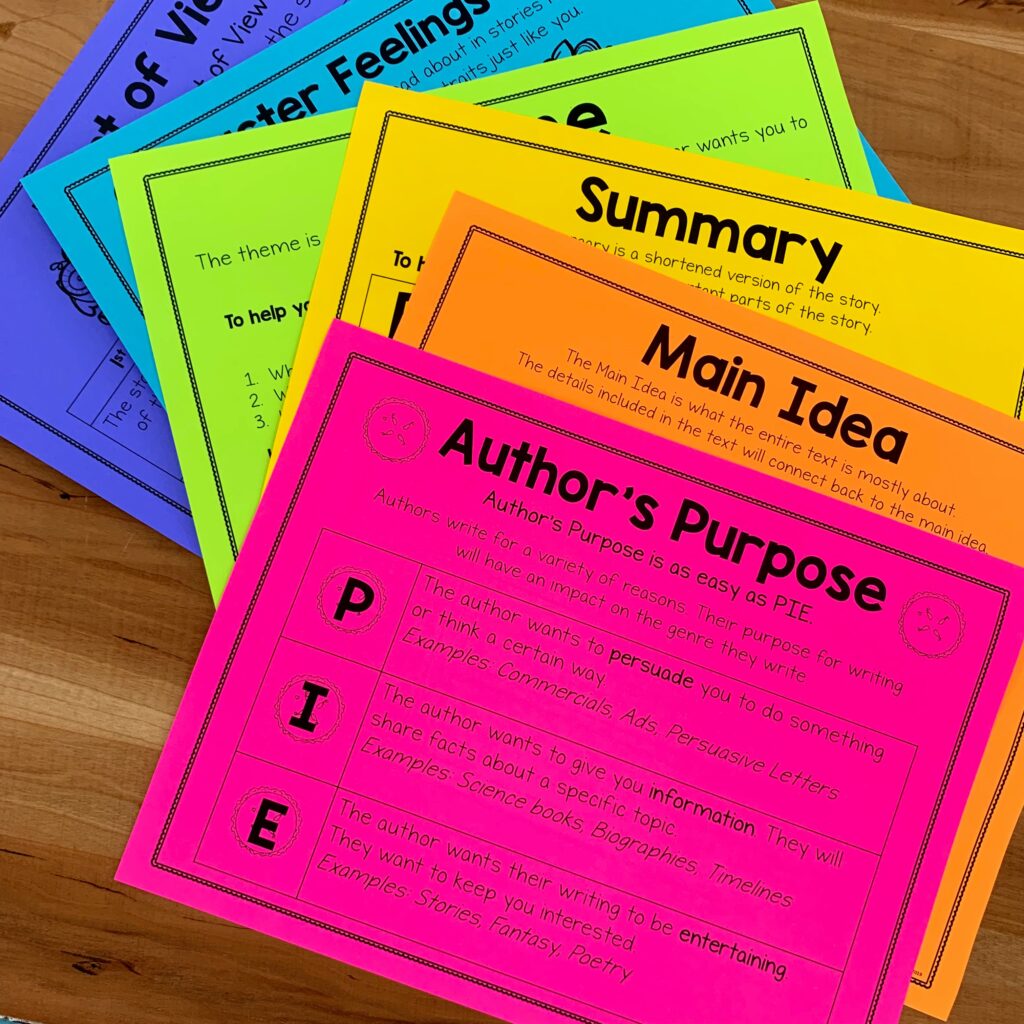
Idea #1: Author's Purpose is as Easy as PIE
Using the acronym PIE is a common way to introduce author's purpose. This acronym covers the three basic reasons why author's write: to persuade, to inform, to entertain.
It is a helpful acronym that students can remember, and the pie analogy makes it pretty cute. BUT, keep in mind that this strategy is pretty basic and only scratches the surface of what we want our students to know when it comes to identifying and understanding author's purpose.
If you start with a PIE anchor chart, be sure to also include some of the other anchor charts in this post in other lessons on author's purpose.
What to include on your anchor chart:
- Possible Title: Author's Purpose or Author's Purpose is as easy as PIE.
- An explanation of what each letter of PIE stands for
- Examples of texts that would fall under each category
- Cute pie icons or images (becuase why not)
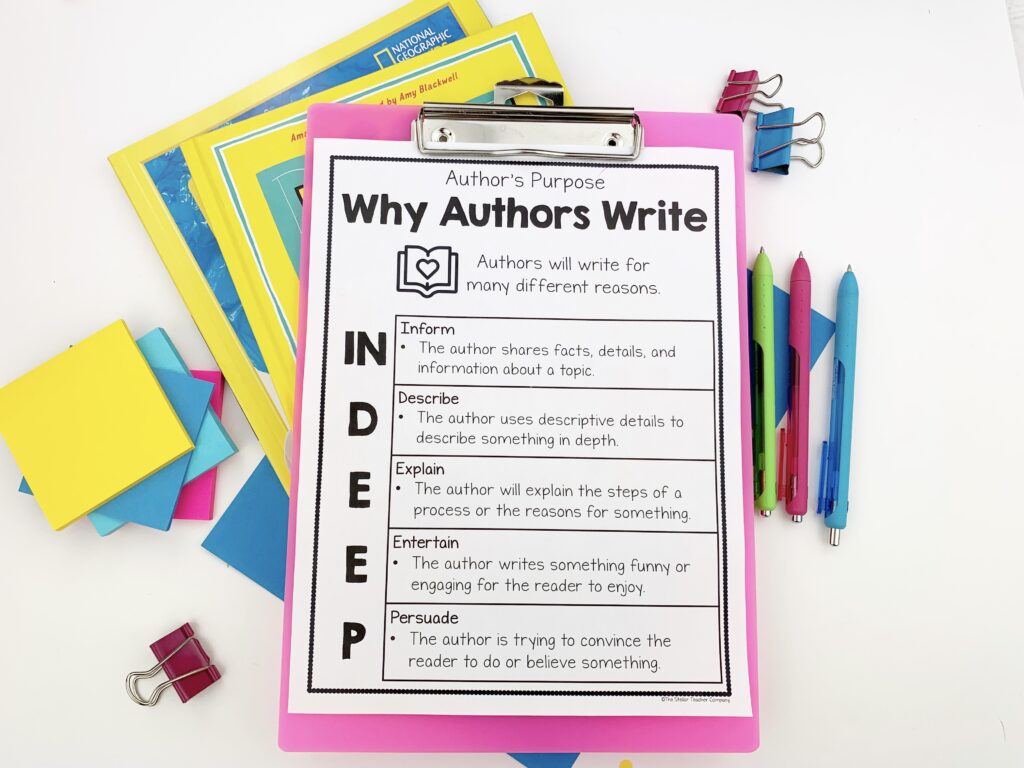
Idea #2: INDEEP
I prefer to use the acronym INDEEP to teach upper elementary students the different types of author's purpose. The acronym InDEEP literally goes a little bit deeper than PIE in explaining the different types of author's purpose.
When introducing author's purpose, I like to exaplain that the author's purpose is basically their reason for writing the text. It explains their goal to the reader.
If you use the InDEEP acronym to introduce author's purpose to your students, you'll cover the following:
- IN = Authors write to inform
- D = Authors write to describe
- E = Authors write to explain
- E = Authors write to entertain
- P = Authors write to persuade
This helps break down nonfiction texts just a little bit better and starts to connect the author's purpose to text structure (which I'll cover in the next anchor chart.
Since author's purpose is really so much more complex than just PIE, I like to use this anchor chart when teaching students the different reason's why authors write.
What to include on your anchor chart:
- Possible Title: Author's Purpose or Why Authors Write
- List out what each letter of InDEEP stands for
- Provide a chart with an explanation of what each type of purpose is (like the picture)
- You could also include an example of each type of purpose if you want to get real fancy
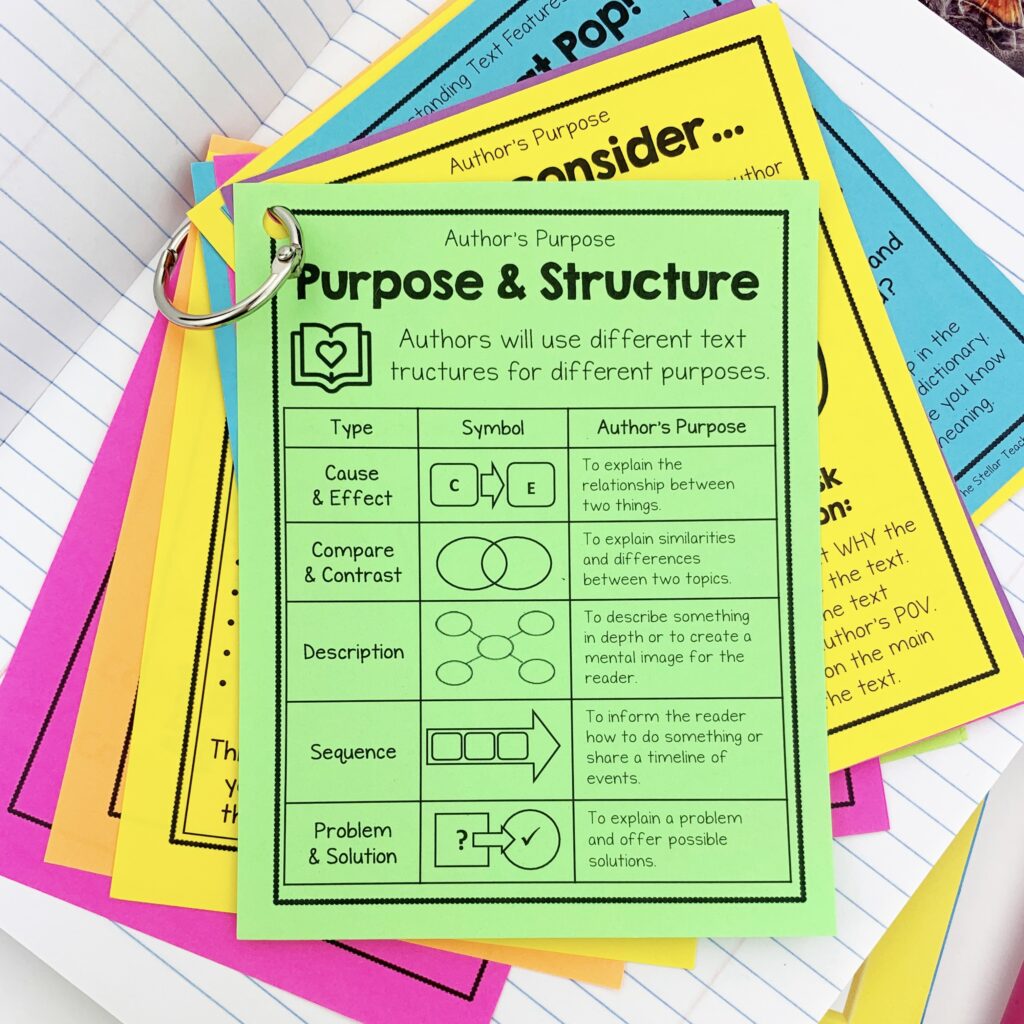
Idea #3: Author's Purpose & Text Structure
One of my favorite things to do when teaching author's purpose (or any reading skill for that matter) is to show students how it connects to all the other reading comprehension skills that they have learned.
Author's purpose has a strong connection to a lot of other reading skills and one of them is text structure.
If you think about it, the reason why an author is wanting to write a text will also impact how they organize their text as well…
If an author wants to describe the taiga biome, they would organize their text with a description text structure.
If an author wants to explain the negative impact of eating too much sugar, they would organize their text with a cause-and-effect text structure.
If an author wants to entertain their readers with a made-up story, they would organize their text with the fictional plot structure.
Author's purpose and text structure go hand-in-hand. If students can recognize one, they should be able to recognize the other. There is a lot of benefit to teaching the connection between author's purpose and text structure.
What to include on your anchor chart:
- Possible Title: Purpose & Structure or The Author's Purpose and Text Structure Connection
- Include a chart or table that shows the type of text structure and how it connects to a specific author's purpose.
- You could create a chart for just nonfiction or one that includes both nonfiction and fiction text structures.
- Anytime I teach about nonfiction text strucutre, I also like to include a visual symbol to help remind students about that text structure so a visual cue is always a good option as well.
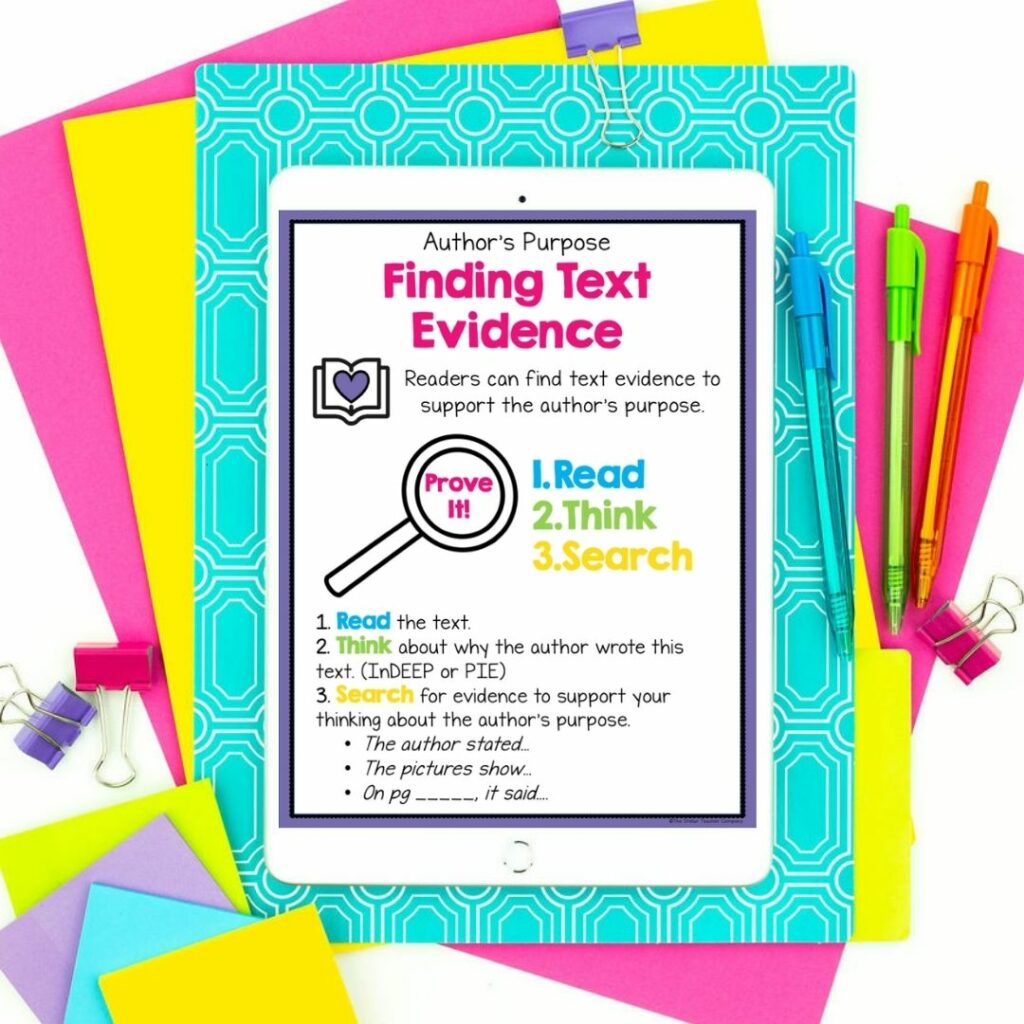
Idea #4 – Finding Text Evidence to Support Author's Prupose
So in order for students to identify the author's purpose of a text, they are going to have to make an inference. Usually, the text doesn't directly state: The author's purpose of this text is to inform the reader…
This means students need to use their inferential thinking skills to be able to figure it out. And one part of being able to make a successful inference is to identify the text clues that support their thinking.
Ultimately, we don't want our students to just guess on the author's purpose, but we want them to be able to find clues in the text that support their thinking about author's purpose.
I always like to throw in a lesson about finding text evidence to support our thinking about author's purpose. If you want to do the same, an anchor chart like the one listed above can be a great tool to support your lesson.
What to include on your anchor chart:
- Possible Title: Finding Text Evidence or Supporting Author's Purpose with Text Evidence
- I like to include a basic step-by-step process to show students what to do. In this example I am encouraging them to 1. Read 2. Think and 3. Search
- I will use a little bit of space at the bottom to expand those steps just a little bit. You can also include examples of text evidence thinking stems that will help them find evidence to support their thinking around author's purpose.
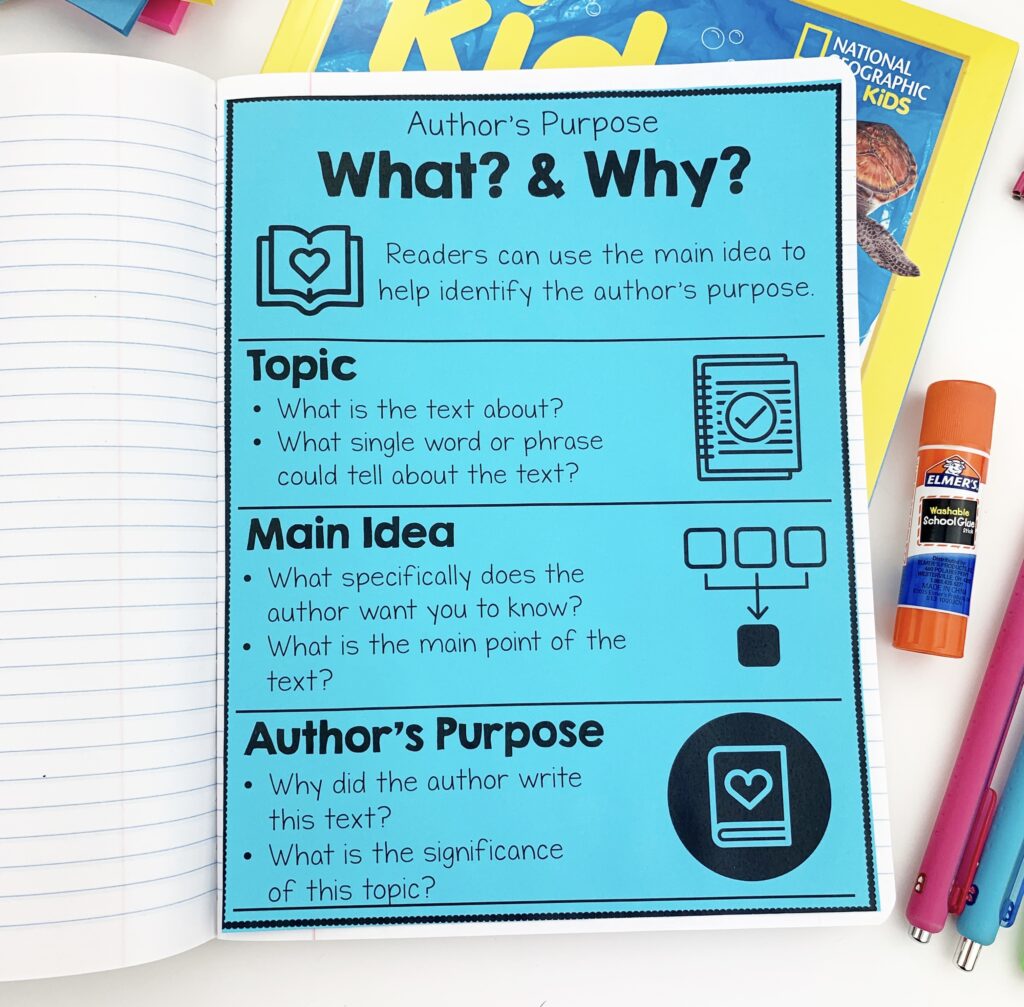
Idea #5: WHAT? and WHY?
Identifying the main idea of a text is another reading skill that has a really strong connection to the author's purpose of a text.
I like to remind students that asking "WHAT is this text about?" will often help them figure out the main idea and "WHY did the author write this text?" will usually help them figure out the author's purpose.
I like teaching reading skills in combination like this because it just gives students more tools to help them understand what they are reading… if they aren't 100% confident in their ability to identify the main idea, then they can use their knowledge and understanding of author's purpose to help them figure it out.
And vice versa. If students don't feel 100% confident in their ability to identify the author's purpose, then they can use their knowledge and understanding of main idea to help them figure it out.
What to include on your anchor chart:
- Possible Title: What? and Why? or Author's Purpose and Main Idea
- I like to include the three categories shown in the example: Topic, Main idea, and Author's Purpose.
- I like to include question stems for each of those categories that will help students identify each. That way if they have this chart glued in their reading journal, they can easily refer back to it while reading indepedently.
- Also, antyime you can include a little icon or visual cue on your anchor chart, it can help make the content easier to understand.
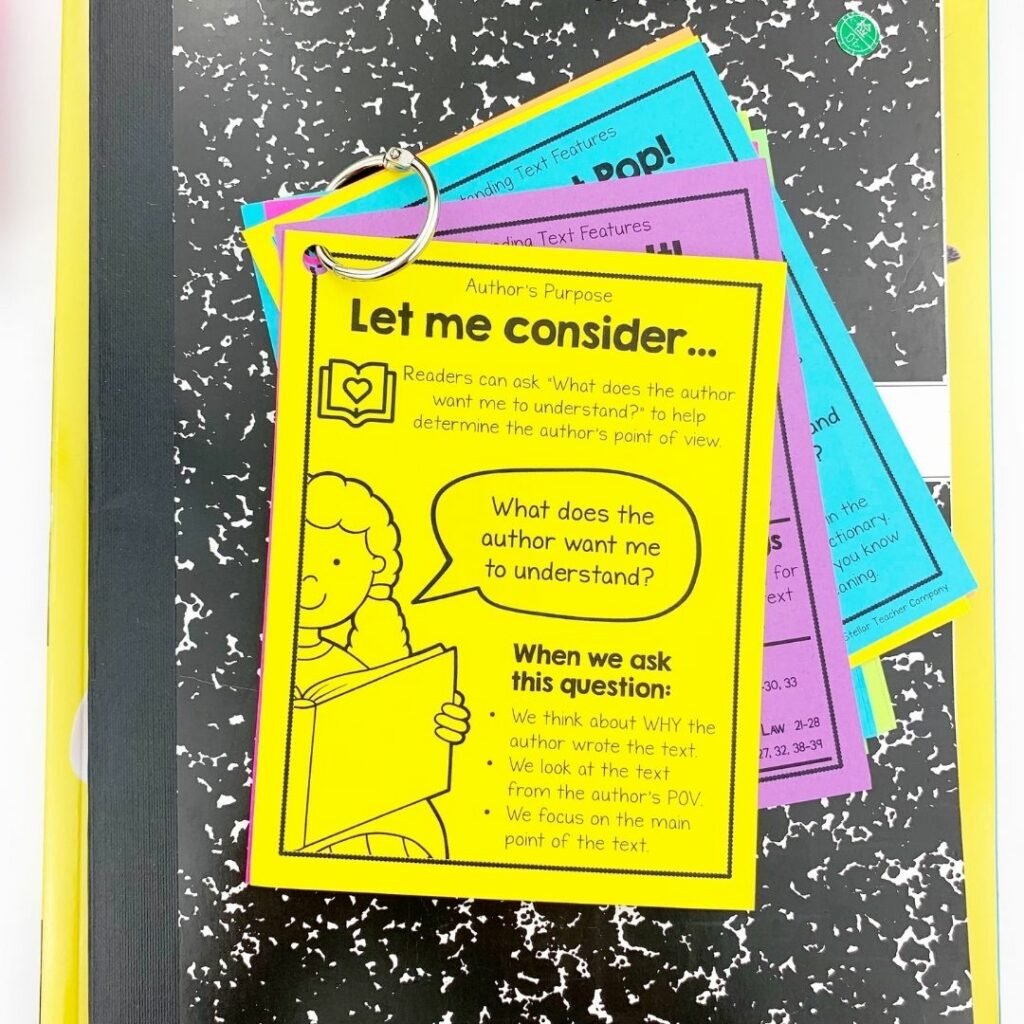
Idea #6: LET ME CONSIDER…
Ok, this is kind of a higher-level lesson, but one that I think is so important. This anchor chart will help your students go beyond just identifying the author's purpose and really help them to think about how the text (and the author's purpose for writing the text) can personally connect to them.
The most important thing about identifying author's purpose is not that students can simply name or state the purpose, but that they can use it to help them understand the text.
Once students have been able to identify the author's purpose of the text, I like to give them this follow-up question: "What does the author want me to understand about this topic?"
This will help them take author's purpose to a whole new level. And this simple question is one that will help them better understand the main idea, summarize the text, and figure out the author's point of view. So many benefits to asking students this question.
So once a student can name the author's purpose for the text, give them this follow-up question and see what type of answers they come up with.
What to include on your anchor chart:
- Possible Title: Let Me Consider or Question the Author
- The most important thing to include on this anchor chart is the question "What does the author want me to understand?"
- You could have a bulleted list that explains why this question is helpful. Or you could even include some specific examples for possible answers depending on the author's purpose of the text.
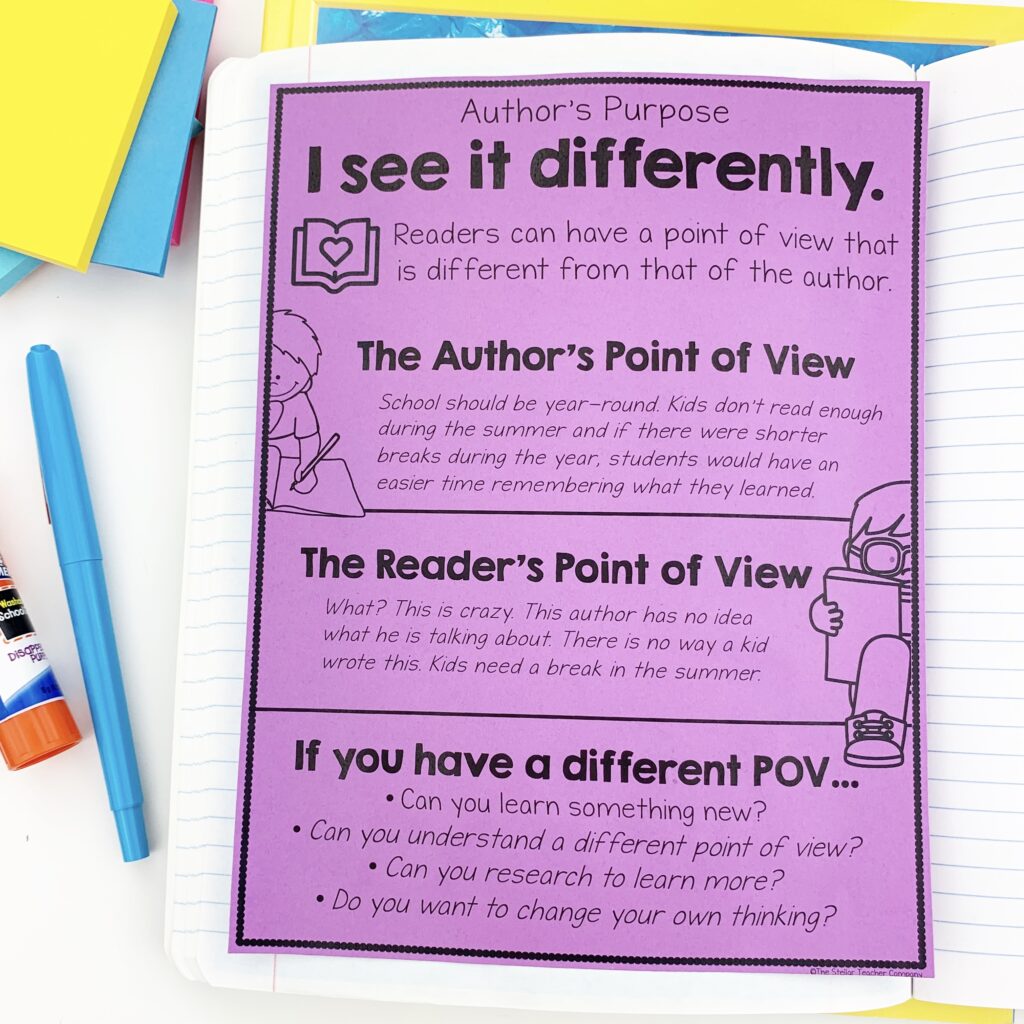
Idea #7: I SEE IT DIFFERENTLY
My final author's purpose anchor chart will help students connect the author's purpose to point of view. I think it's important for students to understand that authors have personal opinions and points of view about the topics that they write about. This will have an impact on WHY and HOW they write.
But just because an author has a certain perspective on a topic doesn't mean that our students have to have the same perspective.
I think it can be really empowering to teach students that sometimes they might see things differently than an author would and that's ok.
If they do find themselves in a situation where they have a different point of view than the author, then there are questions they can ask themselves to help them consider an alternative point of view on the topic.
This can be a great lesson to throw into your author's purpose unit or your unit on point of view.
What to include on your anchor chart:
- Possible Titles: I See It Differently or Reader's POV vs. Author's POV
- Include an explanation of what author's POV is and how that might differ from a reader's POV
- I also like to include a list of questions that students can ask if they ever find themselves reading a text where they don't see eye to eye with the author. These questions can help them keep an open-mind and consider perspectives and opinions that are different than their own.
Put it into Practice…
I love giving you a little action item at the end of my blog posts to help you put these ideas into practice in your own classroom.
First of all, if you are still creating your anchor charts by hand, you are welcome to use any of these ideas to create your own hand-made anchor chart.
BUT, if you are still spending hours each week creating your own anchor charts, I want you to consider switching over to ready-to-print digital anchor charts. You can learn more about the reasons why you should stop making your anchor charts by hand in THIS blog post.
If you aren't teaching author's purpose for a few weeks, then you might want to bookmark this post so you can come back to it when it's time to start preparing for your author's purpose unit.
AND if you like the idea of getting support with your author's purpose unit, then consider joining us inside The Stellar Teacher Reading Membership. We have a whole section of resources to help you teach author's purpose including scripted lesson plans for whole group and small group as well as a variety of reading passages, task cards, and response activities.
Happy Teaching!
Source: https://www.stellarteacher.com/blog/7-anchor-charts-that-dig-deep-into-authors-purpose/
0 Response to "Authors Purpose Easy as Pie Anchor Chart"
Postar um comentário